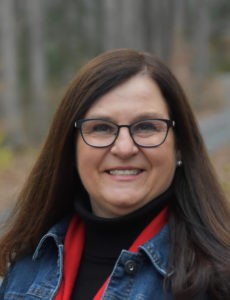Immigrant advocate and social worker Sue Smith has noticed a significant increase in asylum seekers arriving in the United States with severe cases of anxiety and depression, making it harder for them to learn English, enroll their children in schools and hold down jobs.
“Anyone working with these folks is seeing these things,” said Smith, field personnel with the Cooperative Baptist Fellowship serving the Latino community in Fredericksburg, Va., through LUCHA Ministries.
But what has not been seen is statistical evidence to quantify those observations, she added. “I started looking for data and current research on the mental health of those coming across the border and really didn’t find it.”

Sue Smith
So, Smith took matters into her own hands this year by conducting mental health screenings of asylum seekers at the border in Northern Mexico. Her goal was to move beyond assumptions and to equip ministries and shelters to better serve the emotional challenges faced by migrants.
“Everybody knows that Haitians and Central Americans are coming across the border with tremendous amounts of trauma. And everybody acknowledges that they probably have PTSD and significant symptoms of depression,” Smith said. “I want to provide data to strengthen trauma-informed care for people coming through the shelters and to prevent people from being retraumatized.”
The results already have been telling. Smith screened 130 asylum seekers at three shelters in Northern Mexico in April and at two more in September. Participants originating from El Salvador, Guatemala, Honduras, Haiti and Mexico were screened for depression, PTSD and other forms of anxiety and trauma.
The overall indications are that 22% of asylum seekers are experiencing severe to extreme levels of depression.
The overall indications are that 22% of asylum seekers are experiencing severe to extreme levels of depression. Displaced Mexicans still in their home country fared a little better at 18%, compared to Central Americans at 22% and Haitians at 27%, Smith said.
“It looks like displaced people within their own country have a lower level of anxiety, even though many of them experience things that are equally horrible,” she said.
PTSD screening found 61% of asylum seekers scored 33 or higher on the scale for that disorder, which equates to at least a provisional diagnosis for PTSD. A separate anxiety inventory found 39% of migrants are in the moderate-to-severe range for other anxiety disorders.
Smith said she used validated scales to conduct the screenings. “These are scientifically tested and used for research purposes and for academic research. The questions evoke measurable responses. They are shown to have consistent reliability.”
She also used the Beck Depression Inventory to conduct depression screenings.
“These scales enable participants to self-report. We go through the scale together and they read it and answer on their own in Spanish, then I bring it back and analyze the data.”
This is a process Smith has come to use as a social worker and from earning a master’s degree in social work and a doctor of ministry degree in pastoral care focused on serving with Latino immigrants.
But Smith said she also was prepared — and inspired — to conduct the testing by her pastoral work with the border pastor network of Fellowship Southwest. “There are 10 of them scattered across the border, and I have been like a chaplain to them, working with them to ensure they are doing self-care.”
As she engaged in that ministry over the past four years, Smith said she began to notice signs of mental illness among the migrants in the border shelters operated by the pastors.
“I would be surprised if no one had at least some level of depression or PTSD because they have left behind everything they know under extremely traumatic circumstances,” she noted. Yet she uncovered cases of depression so serious that some migrants should have been hospitalized. Many were turning to alcohol to self-medicate the trauma and depression — just as they are doing as asylum seekers in the U.S.
“These kinds of experiences leave deep scars on people.”
“They are just trying to escape the torture they experienced” in their home countries and on their journeys to the United States, Smith said. “These kinds of experiences leave deep scars on people.”
Once in the U.S., the pain is buried even further by the necessity to immediately find work and get families adjusted to their new settings, she explained. “They don’t have time to seek help, even if it’s available in their language.”
Now her hope is that this research will push back against that trend by training shelter workers to provide trauma-informed care for migrants.
Knowledge of the screenings may be spread even wider because two sociologists have expressed interest in publishing the data. In addition, asylum seekers can use the results of their screenings, which are provided to them, to guide their search for mental health treatment assistance in the U.S.
The screenings also can be used in American legal proceedings to establish the credible fear required to achieve asylum, Smith said. “Just coming across the border, for these people, means they probably have PTSD. This scale proves it and gives them a greater chance of being heard and getting assistance, and that really is the goal.”
Related articles:
Title 42 is expelling the good people, not the bad people, border advocate explains
Mission work takes on legal dimensions for Va.-based field personnel


